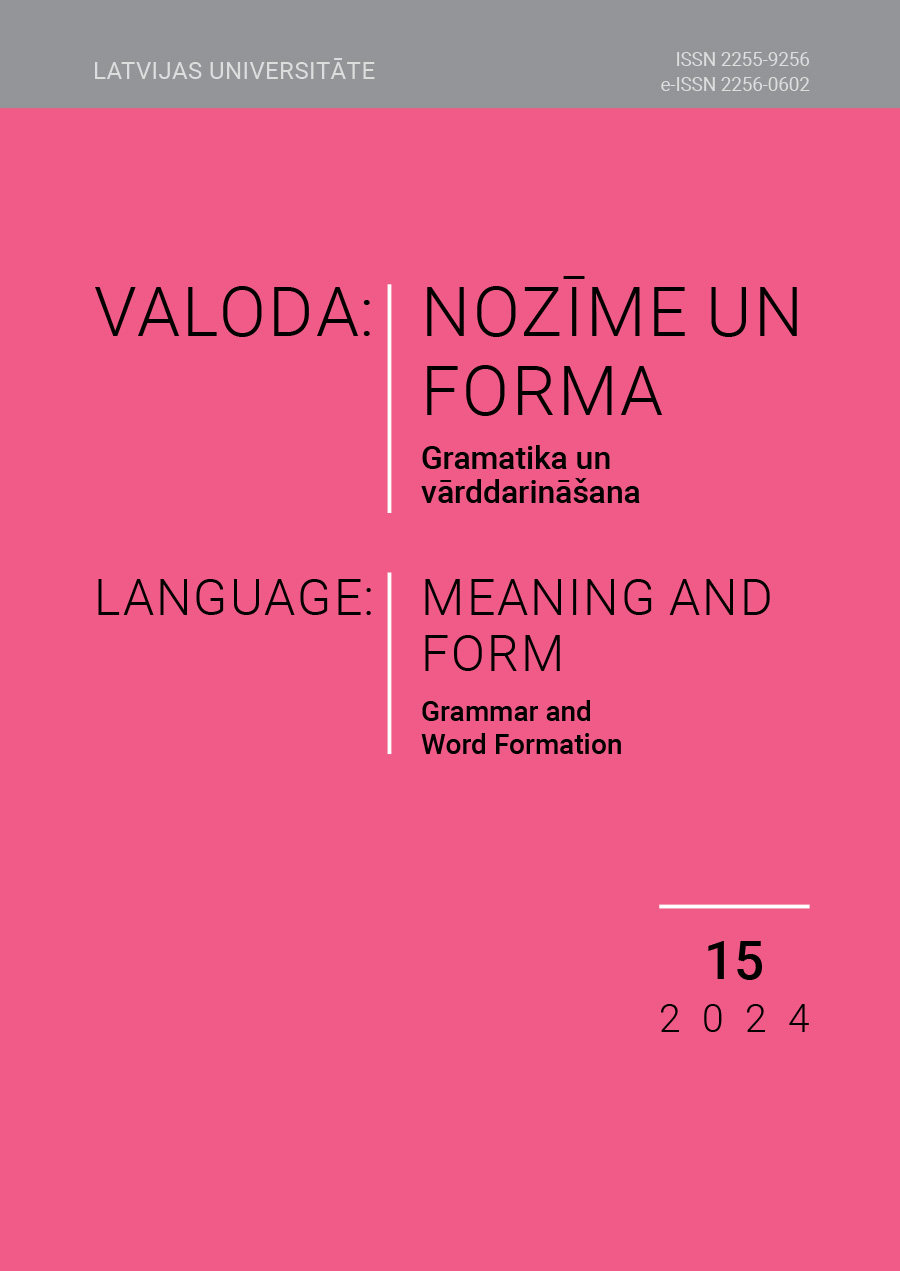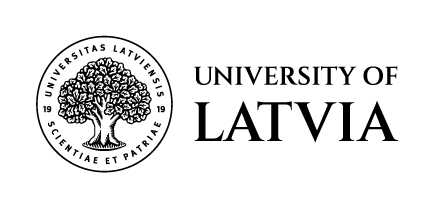The typical phonetic features of colloquial Latvian: Speech corpus data analysis
DOI:
https://doi.org/10.22364/vnf.15.01Keywords:
colloquial language, phonetic characteristics of colloquial language, speech corpus, orthographic transcriptionAbstract
Colloquial language is a territorially unlimited type of national language that is understood by the entire community of speakers and usually serves as the means of informal communication in various everyday situations, in the form of oral questions. The main characteristics of colloquial language are spontaneous oral form and informality of the speech situation. It is also characterized by a specific sentence and text structure, expressiveness, a wide spectrum of stylizing means, a specific vocabulary, diverse use of non-verbal means of communication, etc.
In spoken language, a series of phonetic adjustments takes place, related to the pace of speech, rhythm (regularity of stressed words, change), continuity of speech, pauses and their duration, accuracy of articulation and sound changes. In an effort to economize language resources and make pronunciation easier, speakers sometimes pronounce a sound carelessly or reduce it, which causes both positional changes of sounds in words and a reduction in the number of syllables. The article analyses the phonetic-phonological features characteristic of the colloquial language using the data of the “LATE conversations corpus” (LATE-conversations), that are written in orthographic transcription.
The analysis of LATE-conversations data enables defining several features typical of spoken language: 1) fluctuations in the quantity of vowels; 2) loss of vowels or consonants; 3) phonetic changes of a combined type, which are formed by shortened forms of verbs, shortening of words of compound numbers, imprecise, simplified three and pronunciation of foreign words with more syllables; 4) speech intonation and pauses in utterance.
References
Auziņa, Ilze. 2013. Latviešu valodas fonētiski fonoloģiskie procesi. Latviešu valodas gramatika. Nītiņa, Daina, Grigorjevs, Juris (red.). Rīga: Latvijas Universitātes Latviešu valodas institūts, 80–94.
Auziņa, Ilze. 2014. Pauzes publiskajā runā. Vārds un tā pētīšanas aspekti. 18 (1), 7–13.
Auziņa, Ilze et al. 2022. Specializēta latviešu valodas runas korpusa un izrunas vārdnīcas izveide vizuālās diagnostikas izmeklējumu lingvistiskai analīzei un sistemātiskai transkribēšanai. Letonica. 47, 244–262. DOI: https://doi.org/10.35539/LTNC.2022.0047.I.A.R.D.B.S.N.G.M.G.A.S.K.S.244.263
Auziņa, Ilze, Rābante-Buša, Guna. 2014. Qualitative and quantitative vowel reduction and deletion in the spoken Latvian. Linguistica Lettica. 22, 5–15.
Bendiks, Hermanis. 1965. Lasām, lasāt vai varbūt lasam, lasat? Latviešu valodas kultūras jautājumi. 1, 104–110.
Betz, Simon, Wagner, Petra. 2016. Disfluent lengthening in spontaneous speech. Elektronische Sprachverarbeitung (ESSV). 27, 135–144. Pieejams: https://pub.uni-bielefeld.de/download/2900485/2901408/disfluent-lengthening-spontaneous%288%29.pdf
Bušs, Ojārs. 1984. Ikdienas runas specifika un tās pētīšana. Latviešu valodas kultūras jautājumi. 19, 22–34.
Ceplītis, Laimdots. 1986. Daži problemātiski pareizrunas jautājumi. Latviešu valodas kultūras jautājumi. 22, 31–35.
Crystal, David. 2008. A Dictionary of Linguistics and Phonetics. 6th ed. Oxford: Blackwell Publishing. DOI: https://doi.org/10.1002/9781444302776
Darģis, Roberts et al. 2020. Creation of language resources for the development of a medical speech recognition system for Latvian. Human Language Technologies – the Baltic Perspective. Utka, Andrius et al. (eds.). Amsterdam: IOS Press, 135–141. DOI: https://doi.org/10.3233/FAIA200615
Druviete, Ina. 1989. Sarunvalodas elementi jaunākajā publicistikā. Latviešu valodas kultūras jautājumi. 25, 110–121.
Endzelīns, Jānis. 1938. Latviešu valodas skaņas un formas. Rīga: Latvijas Universitāte. Freimane, Inta. 1993. Valodas kultūra teorētiskā skatījumā. Rīga: Zvaigzne.
Goldman-Eisler, Frieda. 1968. Psycholinguistics: Experiments in Spontaneous Speech. New York: Academic Press.
Grigorjevs, Juris. 2013. Diftongiskie savienojumi. Valoda: nozīme un forma. 3, 38–44. Halliday, Michael Alexander Kirkwood. 1989. Spoken and Written Language. Oxford: Oxford University Press.
Kariņš, Krišjānis A. 1995. Vowel deletion in Latvian. Language Variation and Change. 7(01), 15–34. DOI: https://doi.org/10.1017/S0954394500000880
Laua, Alise. 1997. Latviešu literārās valodas fonētika. Rīga: Zvaigzne ABC.
Lauze, Linda. 2004. Ikdienas saziņa: vienkāršs teikums latviešu sarunvalodā. Liepāja: LiePA.
Lauze, Linda, Auziņa, Ilze. 2019. Dzīvā valoda. Autentiski mutvārdu teksti. Rīga: Latviešu valodas aģentūra.
Lokmane, Ilze. 2009. Publicistikas valodas vieta funkcionālo paveidu un stilu sistēmā. Valoda: nozīme un forma. 1, 5–13.
Markus, Dace. 2013. Galvenās latviešu valodas pareizrunas jeb ortoepijas problēmas. Latviešu valodas gramatika. Nītiņa, Daina, Grigorjevs, Juris (red.). Rīga: Latvijas Universitātes Latviešu valodas institūts, 123–137.
Mežale, Emīlija. 2017. Sarunvalodas stila jēdziens: kopīgais un atšķirīgais latviešu un somu valodā. Res Latvienses. 4, 118–137. https://doi.org/10.22364/RL.4.10 DOI: https://doi.org/10.22364/RL.4.10
Paschen, Ludger, Fuschs, Susanne, Seifart, Frank. 2022. Final lengthening and vowel length in 25 languages. Journal of Phonetics. 94, 1–22. https://doi.org/10.1016/j.wocn.2022.101179 DOI: https://doi.org/10.1016/j.wocn.2022.101179
Pinnis, Mārcis, Auziņa, Ilze, Goba, Kārlis. 2014. Designing the Latvian Speech Recognition Corpus. Proceedings of the Ninth International Conference on Language Resources and Evaluation. Calzolari, Nicoletta et al. (eds.). Reykjavik: European Language Resources Association, 1547–1553.
Rābante-Buša, Guna. 2023. Partikulas kaut izrunas varianti. Vārds un tā pētīšanas aspekti. 27 (1), 184–191. https://doi.org/10.37384/vtpa.2023.27.184 DOI: https://doi.org/10.37384/VTPA.2023.27.184
Rozenbergs, Jānis. 1995. Latviešu valodas stilistika. Rīga: Zvaigzne ABC. Rudzīte, Marta. 1993. Latviešu valodas vēsturiskā fonētika. Rīga: Zvaigzne.
Skujiņa, Valentīna (red.). 2007. Valodniecības pamatterminu skaidrojošā vārdnīca. Rīga: Latvijas Universitātes Latviešu valodas institūts.
Strautiņa, Vaira, Šulce, Dzintra. 2009. Latviešu valodas pareizruna un pareizrakstība. Rīga: RaKa.
Downloads
Published
Issue
Section
License

This work is licensed under a Creative Commons Attribution-NoDerivatives 4.0 International License.


